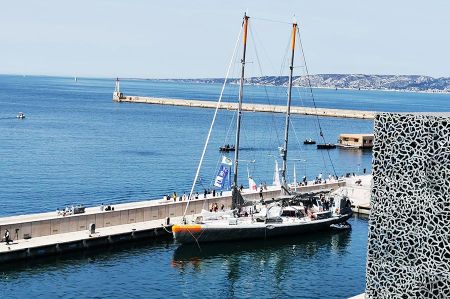Short visit to the Tara – the French research schooner
- Written by Portal Editor
We were guests in Marseille for a few days and came across the Tara more or less by chance as we were heading towards the old port.
We read an article about 15 years ago when this ship was on research trips along the coasts of Greenland, South Georgia and Patagonia and was used as an ice drift station between 2006 and 2008. Just like Fridtjof Nansen once did, they wanted to reach the North Pole. Of course, our interest was piqued. However, we also noticed the barriers and the various television crews filming on and around the ship in the small harbour basin behind the Mucem Museum. After a few questions and some research with the crew members present, another coincidence came to our aid, as there were groups of visitors registered to tour the ship over two days, although one group did not arrive on time. So, we had the opportunity to explore the Tara in more detail.
The North Polar journey of the Tara – a risk like Fridtjof Nansen once did
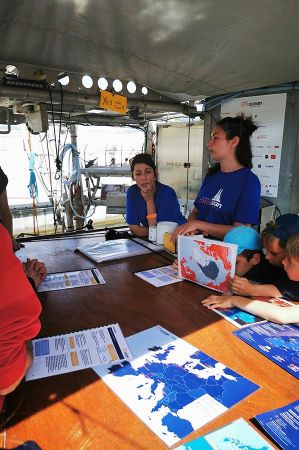 On September 5, 2006, the then eight-man crew under Etienne Bourgois intentionally let the boat freeze in the pack ice a good 800 kilometres north of the Siberian Tiksi at 79 degrees, 53 minutes north latitude and 143 degrees, 17 minutes east longitude. From there, the expedition drifted 5,200 kilometres on the ice and covered 2,600 kilometres as the crow flies to the west. On January 21, 2008, it was released again around 100 km east of Greenland at a latitude of around 72° north. On its drift, the Tara came within 160 kilometres of the North Pole, closer than Fridtjof Nansen's Fram once was.
On September 5, 2006, the then eight-man crew under Etienne Bourgois intentionally let the boat freeze in the pack ice a good 800 kilometres north of the Siberian Tiksi at 79 degrees, 53 minutes north latitude and 143 degrees, 17 minutes east longitude. From there, the expedition drifted 5,200 kilometres on the ice and covered 2,600 kilometres as the crow flies to the west. On January 21, 2008, it was released again around 100 km east of Greenland at a latitude of around 72° north. On its drift, the Tara came within 160 kilometres of the North Pole, closer than Fridtjof Nansen's Fram once was.
In his work as a polar researcher, Nansen was the first to cross Greenland over the ice cap in 1888 and set a new record with a latitude of 86° 13.6' N during his North Polar expedition (1893–1896) together with Fredrik Hjalmar Johansen on April 8, 1895 the closest approach achieved to date with his “Fram” to the geographical North Pole. He revolutionized the techniques of polar travel and thereby influenced all subsequent expeditions in the Arctic and Antarctic.
On February 23, 2008, the Tara reached its home port of Lorient in the Morbihan department in Brittany. The name Lorient comes from L’Orient (the Orient), as this was once the home port of the French East India Company. From the beginning, the port was the centre of an extensive trade network that linked the businesses of numerous traders, merchants and producers across Europe. Here the ships set off for the Mascarene Islands, India or China to return from the Orient with the coveted goods of silk, gold and spices.
But now back to the tare – drifting technique
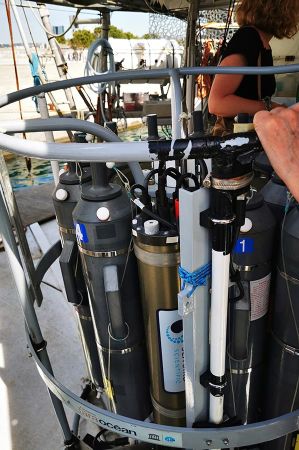 The expedition used the same technology that Nansen had used to attempt to reach the North Pole in 1893. The schooner, which is almost 35 meters long and around ten meters wide, has a round hull that is pushed up when it freezes in the ice and rests on the ice.
The expedition used the same technology that Nansen had used to attempt to reach the North Pole in 1893. The schooner, which is almost 35 meters long and around ten meters wide, has a round hull that is pushed up when it freezes in the ice and rests on the ice.
For this purpose, on September 5, 2006, the ship moored on an ice floe three times one and a half kilometres in size. The path to the starting point of the expedition was paved by an icebreaker.
The ship spent a total of two polar nights in the Arctic. Between April and September 2007, additional scientists were flown in and pitched their tents next to Tara.
Scientific goals of this dangerous mission
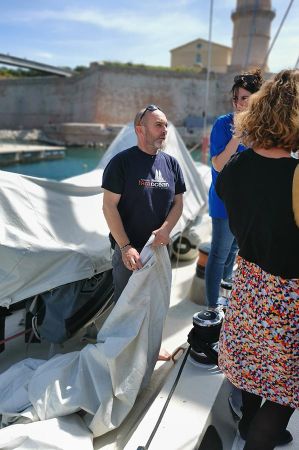 The expedition members were already investigating the effects of climate change back then. This included meteorological observations up to two kilometres high using helium-filled probes; a determination of the radiation balance, measurements of water content, density and thickness of the snow layer, as well as the thickness of the ice floes; Examination of the water layers for temperature and salinity with probes attached to cables down to a depth of 4000 meters. The seawater was analysed for its content of the oxygen isotope 18O to determine the proportion of freshwater from the mainland. The iodine isotope 126I was used to trace whether residues from the reprocessing plants in La Hague and Sellafield reached the Arctic.
The expedition members were already investigating the effects of climate change back then. This included meteorological observations up to two kilometres high using helium-filled probes; a determination of the radiation balance, measurements of water content, density and thickness of the snow layer, as well as the thickness of the ice floes; Examination of the water layers for temperature and salinity with probes attached to cables down to a depth of 4000 meters. The seawater was analysed for its content of the oxygen isotope 18O to determine the proportion of freshwater from the mainland. The iodine isotope 126I was used to trace whether residues from the reprocessing plants in La Hague and Sellafield reached the Arctic.
What particularly amazed scientists was how quickly the ice drifted; the record was 120 nautical miles in ten days, which corresponds to one kilometre per hour. The Tara needed less than half as much time to drift with the ice as the Fram did around 110 years earlier, although the Tara travelled several 100 km longer. The expedition was able to confirm that the ice cover at the North Pole is shrinking. At 1½ to 2 m, the average ice thickness was only around half as much as twenty years earlier. In addition, perennial ice is increasingly being replaced by one-year ice, which thaws away completely in summer.
Other studies have also been frightening
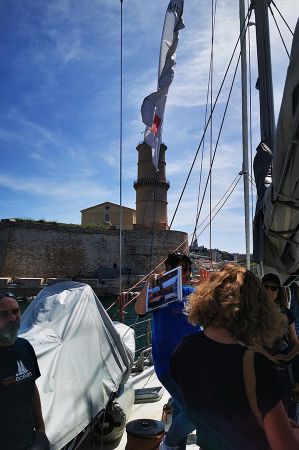 The scientists also examined the air specifically for its content of ozone, mercury and bromine oxide. The background to these measurements is the phenomenon that mercury and ozone completely disappear from the air near the ice in spring, for which bromine oxide is believed to be responsible. A pollen trap also caught pollen.
The scientists also examined the air specifically for its content of ozone, mercury and bromine oxide. The background to these measurements is the phenomenon that mercury and ozone completely disappear from the air near the ice in spring, for which bromine oxide is believed to be responsible. A pollen trap also caught pollen.
In the biological part of the work program, plankton was collected to determine the primary production of the ocean. Psychrophilic bacteria are so adapted to life in the cold that they manage to survive even in ice. Birds should also be observed, especially the endangered ivory gulls, and the songs and ultrasonic clicks of whales should be recorded.
The project was funded by the EU as part of the “Damocles” program. It was part of the International Polar Year that was announced for 2007/2008.
Today's missions and tasks - explained on board
Today's activities are also similar
Once on board the Tara, the crew members explained to us the current activities of the schooner's research trips, which travel almost continuously on the world's oceans. The focus at the moment is clearly on research into water quality and thus the problem of microplastics, which was explained in detail. In general, it was interesting to have all the technical equipment of the schooner explained, which was at least partly completely new territory for us. Since the context was well explained, the visit to the ship was a novelty for us, which we enjoyed.
Bremerhaven-based Polarstern also conducts comparable research
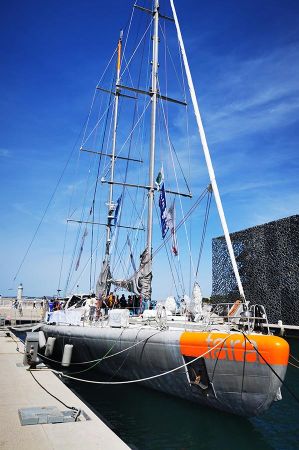 The Bremerhaven research ship “Polarstern” was frozen in the Arctic for a year from September 2019. The aim of the mission: to research the influence of the polar region on the global climate.
The Bremerhaven research ship “Polarstern” was frozen in the Arctic for a year from September 2019. The aim of the mission: to research the influence of the polar region on the global climate.
It was the largest Arctic research expedition of all time: In September 2019, the German research icebreaker “Polarstern” set off from Tromsø in Norway to the Arctic and drifted through the Arctic Ocean frozen in the Arctic ice for a year. Supplied by additional icebreakers and aircraft, 600 people from 17 countries took part in the polar adventure. The mission was led by the Alfred Wegener Institute, Helmholtz Centre for Polar and Marine Research.
The German research ship “Polarstern” reached the North Pole on September 7th, 2023. Their goal is to mathematically model the evolution of Arctic ice. Six weeks of polar bear sightings, helicopter flights and isolation in the Arctic cold are behind them. The most impressive part of their journey so far, however, is their arrival at the North Pole.
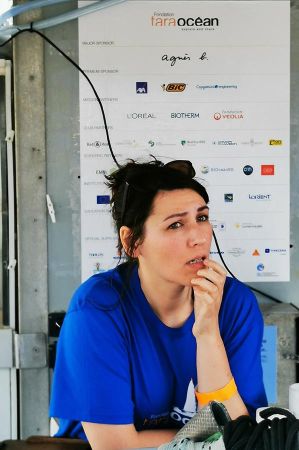 "We rushed through the last hundred kilometres with only a third of the available engine power. In the 1990s, two icebreakers were still needed. This impressively shows how quickly the climate change we have caused is leading to changes in this huge Arctic ecosystem," reports Carolin Mehlmann.
"We rushed through the last hundred kilometres with only a third of the available engine power. In the 1990s, two icebreakers were still needed. This impressively shows how quickly the climate change we have caused is leading to changes in this huge Arctic ecosystem," reports Carolin Mehlmann.
We wish you good luck with future excursions and at the same time very much hope that the scientific findings and the resulting clear and absolutely necessary change in human behaviour, especially in industry, will be brought about by the human destruction of our living space and thus our very existence can be changed in a timely manner. Probably the most famous prophecy of the Cree Indians:
“Only when the last tree has been cleared, the last river has been poisoned, the last fish has been caught, will you realize that you cannot eat money.”
In November 1972, Thomas Porter, alias Sakokwenionkwas, a Mohawk spokesman, used the image of the last tree and last fish and money in a speech at Harvard University addressed to President Richard Nixon. Everything that could have been changed in the last 50 years is now becoming more and more expensive and difficult!
Please read as well:
Hottest stars of pop music in Prague - British singer Raye
Ljubljana - first impressions and historical background
-
 Tara - Sailing and expedition to North-pole
Tara - Sailing and expedition to North-pole
Tara - Sailing and expedition to North-pole
Tara - Sailing and expedition to North-pole
-
 Tara - Sailing and expedition to North-pole
Tara - Sailing and expedition to North-pole
Tara - Sailing and expedition to North-pole
Tara - Sailing and expedition to North-pole
-
 Tara - Sailing and expedition to North-pole
Tara - Sailing and expedition to North-pole
Tara - Sailing and expedition to North-pole
Tara - Sailing and expedition to North-pole
-
 Tara - Sailing and expedition to North-pole
Tara - Sailing and expedition to North-pole
Tara - Sailing and expedition to North-pole
Tara - Sailing and expedition to North-pole
-
 Tara - Sailing and expedition to North-pole
Tara - Sailing and expedition to North-pole
Tara - Sailing and expedition to North-pole
Tara - Sailing and expedition to North-pole
-
 Tara - Sailing and expedition to North-pole
Tara - Sailing and expedition to North-pole
Tara - Sailing and expedition to North-pole
Tara - Sailing and expedition to North-pole
-
 Tara - Sailing and expedition to North-pole
Tara - Sailing and expedition to North-pole
Tara - Sailing and expedition to North-pole
Tara - Sailing and expedition to North-pole
-
 Tara - Sailing and expedition to North-pole
Tara - Sailing and expedition to North-pole
Tara - Sailing and expedition to North-pole
Tara - Sailing and expedition to North-pole
-
 Tara - Sailing and expedition to North-pole
Tara - Sailing and expedition to North-pole
Tara - Sailing and expedition to North-pole
Tara - Sailing and expedition to North-pole
-
 Tara - Sailing and expedition to North-pole
Tara - Sailing and expedition to North-pole
Tara - Sailing and expedition to North-pole
Tara - Sailing and expedition to North-pole
-
 Tara - Sailing and expedition to North-pole
Tara - Sailing and expedition to North-pole
Tara - Sailing and expedition to North-pole
Tara - Sailing and expedition to North-pole
-
 Tara - Sailing and expedition to North-pole
Tara - Sailing and expedition to North-pole
Tara - Sailing and expedition to North-pole
Tara - Sailing and expedition to North-pole
-
 Tara - Sailing and expedition to North-pole
Tara - Sailing and expedition to North-pole
Tara - Sailing and expedition to North-pole
Tara - Sailing and expedition to North-pole
-
 Tara - Sailing and expedition to North-pole
Tara - Sailing and expedition to North-pole
Tara - Sailing and expedition to North-pole
Tara - Sailing and expedition to North-pole
-
 Tara - Sailing and expedition to North-pole
Tara - Sailing and expedition to North-pole
Tara - Sailing and expedition to North-pole
Tara - Sailing and expedition to North-pole
https://www.alaturka.info/en/france/marseilles/6600-short-visit-to-the-tara-the-french-research-schooner?layout=default%2Famp%2Famp%2Famp%2Famp%2Famp%2Famp%2Famp%2Famp%2Famp%2Famp%2Famp%2Famp%2Famp%2Famp%2Famp%2Famp%2Famp%2Famp%2Famp%2Famp%2Famp%2Famp%2Famp%2Famp%2Famp%2Famp%2Famp%2Famp%2Famp%2Famp%2Famp%2Famp#sigProIdddc661e011
